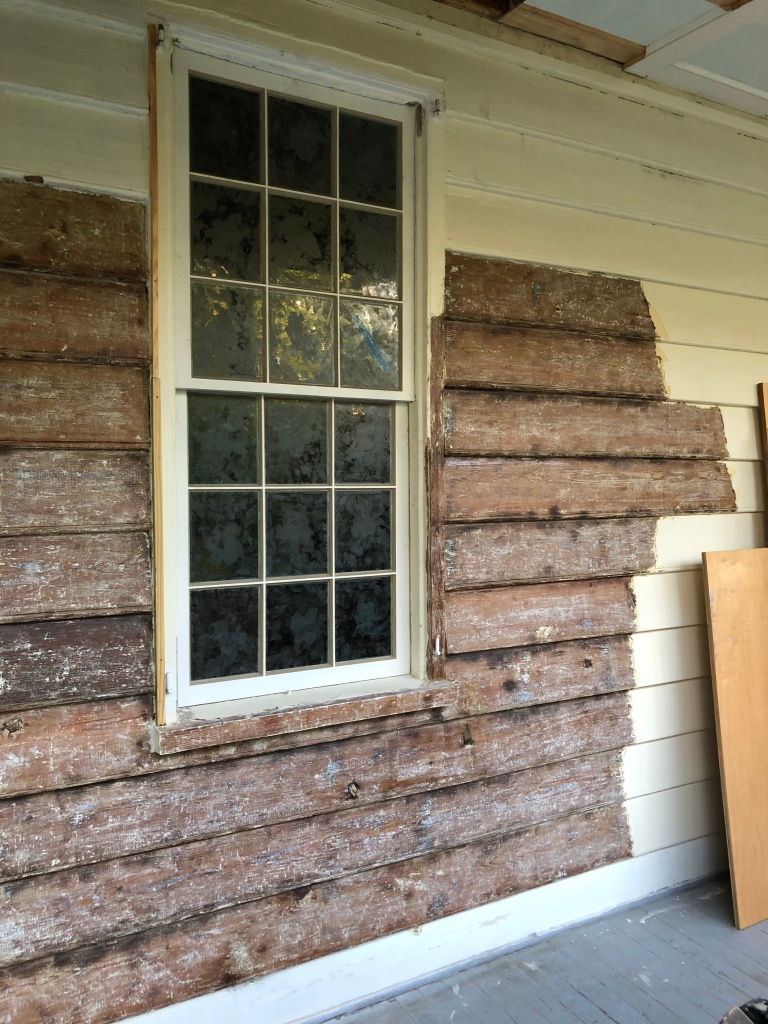Why I’m Wielding a Heat Gun on Sultry Summer Days
It’s all in the details as the saying goes – and with historic houses, once details are gone, they are often gone for good. And details are why I am stripping paint here at the Chancognie House in the midst of a heat wave.

The wooden siding on the Chancognie House was made with a bead on the edge – an extra bit of detailing that would have given the house a more refined look. But, as you can see in the photo above, layers of paint have filled the bead – so much so that the siding almost looks like plain boards without the extra detail.

During recent repairs to the piazza, extensive damage to the soffit was discovered and a section had to be removed. The soffit had to be stripped so that it could be reassembled – old paint had built up to such an extent that it could not be properly reset without doing so.

I had not stripped paint in a while, but I picked up a heat gun and started in on the soffit. Despite the fact that the heat index here in Charleston has regularly been around or above 100 degrees recently, I really enjoyed the process. There is something incredibly satisfying about revealing architectural detail that has been obscured by layers of paint for years, especially when that detail is as intricate and delicate as that here at the Chancognie House.

Historic sites take different approaches to removing paint and some sites remove paint to reveal architectural details while others never remove paint in order to keep the paint history intact. I take a hybrid approach here – I work with Dr. Susan L. Buck, historic paint analyst, to take samples from the house so that we can determine the original paint scheme, which in the case of the piazza, trim and the siding of the house, was a cream color. Then I preserve sections of the paint record for comparison and future reference and remove paint accumulation to reveal the original architectural details of the house. I feel strongly that it is important to reveal this detail as it significantly changes the look, feel and interpretation of the house. What appears to be heavy detail under what Dr. Buck has determined is almost thirty layers of paint in some areas, is transformed into delicate detail without all of the paint.

This brings me back to the siding on the house. Inspired by the revelation of detail from stripping the soffit, I decided that the bead on the siding deserved to be restored too. My current plan is to do the areas under the first and second floor of the piazza now, since that is where the paint build-up is most severe and most noticeable. The protection afforded by the piazzas allowed the paint to accumulate more than on other areas of the house. After that, I will evaluate which areas to do next – the paint stripping process is a slow and deliberate one – the above photo was taken after four days of work.

With the construction of the new addition going on for the past year and a half, projects on the original house had mostly been on hold and this current project made me realize how much I miss working on the house. I have learned quite a bit and as usual, now have more questions, which I will address in an upcoming post. In the meantime, here’s hoping for some cooler weather soon!

Hi,
Actually my budget is very limited,
So can you say any heat gun to remove the paint would be good for me?
With which I can remove paint on metal, wood, walls and more? And how long will it last?
LikeLiked by 1 person
Good questions! I have only used the Makita HG1100 heat gun (which has been discontinued, but there is an updated model), so I cannot offer any insight into other brands. Makita makes a professional grade heat gun, so it has a better motor and is designed for heavy-duty work. While it is more expensive than other brands, it has great longevity – the heat gun pictured in this blog post is one owned by my contractor and he has had it for over 20 years. I do not use it around glass because it gets too hot, so for windows and metal accessories such as latches and hooks, I use a chemical paint stripper. I hope this helps – please let me know if I can provide any additional insight!
LikeLike